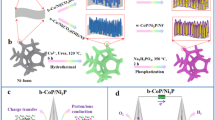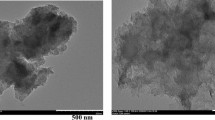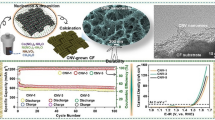Abstract
We report the synthesis of a composite from cobalt porphyrin-based metal organic framework (MOF) and multi-walled carbon nanotube (MWCNT), possessing good catalytic activity toward oxygen reduction (OR) and oxygen evolution (OE) processes. A 3-D porous coordination network (PCN) with 3-D nanochannels was synthesized using ultrastable Zr6 clusters and tetrakis(4-carboxyphenyl)porphyrin cobalt(II). Located in the backbone of MOF, cobalt porphyrins as the active centers are easily accessible to the reactants. The composite exhibits smaller overpotentials and higher current for OR and OE reactions compared to the commercial Pt/C catalyst. A proton-coupled electron transfer mechanism has been suggested due to the pH dependence of water oxidation on the electrocatalyst. Furthermore, the stability of the catalyst has been verified by various techniques. Our designed heterogeneous, inexpensive, and stable electrocatalyst is a proper candidate for acidic fuel cells and water splitting devices under near neutral condition without requirement of pyrolysis process.








Similar content being viewed by others
References
Lewis NS, Nocera DG (2006) Powering the planet: chemical challenges in solar energy utilization. Proc Natl Acad Sci 103:15729–15735
Vielstich W, Lamm A, Gasteiger HA (2003) Handbook of fuel cells: fundamentals, technology, applications, 4-volume set. Wiley, New York
Zheng Y, Jiao Y, Jaroniec M, Qiao SZ (2015) Advancing the electrochemistry of the hydrogen-evolution reaction through combining experiment and theory. Angew Chemie Int Ed 54:52–65
Trasatti S (1984) Electrocatalysis in the anodic evolution of oxygen and chlorine. Electrochim Acta 29:1503–1512
Yang L, Larouche N, Chenitz R et al (2015) Activity, performance, and durability for the reduction of oxygen in PEM fuel cells, of Fe/N/C electrocatalysts obtained from the pyrolysis of metal-organic-framework and iron porphyrin precursors. Electrochim Acta 159:184–197
Cao L, Zhang G, Jiang S et al (2016) Enhancing the oxygen reduction reaction performance by modifying the surface of platinum nanoparticles. ChemElectroChem 3:309–317
Fortunato GV, Venarusso LB, Maia G (2014) Large platinum structures as promising catalysts for the oxygen-reduction reaction. ChemElectroChem 1:625–636
Browne MP, Nolan H, Duesberg GS et al (2016) Low-overpotential high-activity mixed manganese and ruthenium oxide electrocatalysts for oxygen evolution reaction in alkaline media. ACS Catal 6:2408–2415
Antolini E (2014) Iridium as catalyst and cocatalyst for oxygen evolution/reduction in acidic polymer electrolyte membrane electrolyzers and fuel cells. Acs Catal 4:1426–1440
Zhan Y, Du G, Yang S et al (2015) Development of cobalt hydroxide as a bifunctional catalyst for oxygen electrocatalysis in alkaline solution. ACS Appl Mater Interfaces 7:12930–12936. https://doi.org/10.1021/acsami.5b02670
Wu Y, Zang J, Dong L et al (2016) High performance and bifunctional cobalt-embedded nitrogen doped carbon/nanodiamond electrocatalysts for oxygen reduction and oxygen evolution reactions in alkaline media. J Power Sources 305:64–71
Han Y, Wu Y, Lai W, Cao R (2015) Electrocatalytic water oxidation by a water-soluble nickel porphyrin complex at neutral pH with low overpotential. Inorg Chem 54:5604–5613
Zhan T, Zhang Y, Liu X et al (2016) NiFe layered double hydroxide/reduced graphene oxide nanohybrid as an efficient bifunctional electrocatalyst for oxygen evolution and reduction reactions. J Power Sources 333:53–60
Yuan S, Shui J, Grabstanowicz L et al (2013) A highly active and support-free oxygen reduction catalyst prepared from ultrahigh-surface-area porous polyporphyrin. Angew Chemie Int Ed 52:8349–8353. https://doi.org/10.1002/anie.201302924
Wu Z-S, Chen L, Liu J et al (2014) High-performance electrocatalysts for oxygen reduction derived from cobalt porphyrin-based conjugated mesoporous polymers. Adv Mater 26:1450–1455. https://doi.org/10.1002/adma.201304147
Chowdhury DR, Spiccia L, Amritphale SS et al (2016) A robust iron oxyhydroxide water oxidation catalyst operating under near neutral and alkaline conditions. J Mater Chem A 4:3655–3660
Zhang Y, Xiao Q, Guo X et al (2015) A novel electrocatalyst for oxygen evolution reaction based on rational anchoring of cobalt carbonate hydroxide hydrate on multiwall carbon nanotubes. J Power Sources 278:464–472
He J, Li B, Mao J et al (2017) Four-electron oxygen reduction from mesoporous carbon modified with Fe2O3 nanocrystals. J Mater Sci 52:10938–10947
Liu M, Song Y, He S et al (2014) Nitrogen-doped graphene nanoribbons as efficient metal-free electrocatalysts for oxygen reduction. ACS Appl Mater Interfaces 6:4214–4222. https://doi.org/10.1021/am405900r
Liu S, Zhang H, Zhao Q et al (2016) Metal-organic framework derived nitrogen-doped porous carbon@ graphene sandwich-like structured composites as bifunctional electrocatalysts for oxygen reduction and evolution reactions. Carbon N Y 106:74–83
Cheon JY, Kim T, Choi Y et al (2013) Ordered mesoporous porphyrinic carbons with very high electrocatalytic activity for the oxygen reduction reaction. Sci Rep 3:1–8. https://doi.org/10.1038/srep02715
Cao R, Thapa R, Kim H et al (2013) Promotion of oxygen reduction by a bio-inspired tethered iron phthalocyanine carbon nanotube-based catalyst. Nat Commun 4:1–7. https://doi.org/10.1038/ncomms3076
Xiang Z, Xue Y, Cao D et al (2014) Highly efficient electrocatalysts for oxygen reduction based on 2D covalent organic polymers complexed with non-precious metals. Angew Chemie Int Ed 53:2433–2437. https://doi.org/10.1002/anie.201308896
Zoladek S, Rutkowska IA, Blicharska M et al (2016) Enhancement of oxygen reduction at Co-porphyrin catalyst by supporting onto hybrid multi-layered film of polypyrrole and polyoxometalate-modified gold nanoparticles. J Solid State Electrochem 20:1199–1208
Jiang L, Cui L, He X (2015) Cobalt-porphyrin noncovalently functionalized graphene as nonprecious-metal electrocatalyst for oxygen reduction reaction in an alkaline medium. J Solid State Electrochem 19:497–506
Nakazono T, Parent AR, Sakai K (2013) Cobalt porphyrins as homogeneous catalysts for water oxidation. Chem Commun 49:6325–6327
Dogutan DK, McGuire R Jr, Nocera DG (2011) Electocatalytic water oxidation by cobalt (III) hangman β-octafluoro corroles. J Am Chem Soc 133:9178–9180
Han A, Jia H, Ma H et al (2014) Cobalt porphyrin electrode films for electrocatalytic water oxidation. Phys Chem Chem Phys 16:11224–11232
Jia H, Sun Z, Jiang D, Du P (2015) Covalent cobalt porphyrin framework on multiwalled carbon nanotubes for efficient water oxidation at low overpotential. Chem Mater 27:4586–4593
Aiyappa HB, Thote J, Shinde DB et al (2016) Cobalt-modified covalent organic framework as a robust water oxidation electrocatalyst. Chem Mater 28:4375–4379
Kanan MW, Nocera DG (2008) In situ formation of an oxygen-evolving catalyst in neutral water containing phosphate and Co2+. Science (80-) 321:1072–1075
Schoedel A, Li M, Li D et al (2016) Structures of metal-organic frameworks with rod secondary building units. Chem Rev 116:12466–12535
Paz FAA, Klinowski J, Vilela SMF et al (2012) Ligand design for functional metal–organic frameworks. Chem Soc Rev 41:1088–1110
Flügel EA, Lau VW, Schlomberg H et al (2016) Homonuclear mixed-valent cobalt imidazolate framework for oxygen-evolution electrocatalysis. Chem Eur J 22:3676–3680
Jiang M, Li L, Zhu D et al (2014) Oxygen reduction in the nanocage of metal–organic frameworks with an electron transfer mediator. J Mater Chem A 2:5323–5329. https://doi.org/10.1039/c3ta15319c
Wang C, Xie Z, deKrafft KE, Lin W (2011) Doping metal–organic frameworks for water oxidation, carbon dioxide reduction, and organic photocatalysis. J Am Chem Soc 133:13445–13454
Han J, Wang D, Du Y et al (2016) Polyoxometalate immobilized in MIL-101 (Cr) as an efficient catalyst for water oxidation. Appl Catal A Gen 521:83–89
Manna P, Debgupta J, Bose S, Das SK (2016) A mononuclear coii coordination complex locked in a confined space and acting as an electrochemical water-oxidation catalyst: a “ship-in-a-bottle” approach. Angew Chemie Int Ed 55:2425–2430
Yang L, Gao M, Dai B et al (2016) An efficient NiS@ N/SC hybrid oxygen evolution electrocatalyst derived from metal-organic framework. Electrochim Acta 191:813–820
Yu X-Y, Feng Y, Guan B et al (2016) Carbon coated porous nickel phosphides nanoplates for highly efficient oxygen evolution reaction. Energy Environ Sci 9:1246–1250
Li X, Fang Y, Wen L et al (2016) Co@ Co 3 O 4 core–shell particle encapsulated N-doped mesoporous carbon cage hybrids as active and durable oxygen-evolving catalysts. Dalt Trans 45:5575–5582
Jiang J, Zhang C, Ai L (2016) Hierarchical iron nickel oxide architectures derived from metal-organic frameworks as efficient electrocatalysts for oxygen evolution reaction. Electrochim Acta 208:17–24
Feng Y, Yu X-Y, Paik U (2016) N-doped graphene layers encapsulated NiFe alloy nanoparticles derived from MOFs with superior electrochemical performance for oxygen evolution reaction. Sci Rep 6:34004
Ming F, Liang H, Shi H et al (2016) MOF-derived Co-doped nickel selenide/C electrocatalysts supported on Ni foam for overall water splitting. J Mater Chem A 4:15148–15155
Zhao P, Hua X, Xu W et al (2016) Metal–organic framework-derived hybrid of Fe 3 C nanorod-encapsulated, N-doped CNTs on porous carbon sheets for highly efficient oxygen reduction and water oxidation. Catal Sci Technol 6:6365–6371
Xia W, Zou R, An L et al (2015) A metal–organic framework route to in situ encapsulation of Co@ Co 3 O 4@ C core@ bishell nanoparticles into a highly ordered porous carbon matrix for oxygen reduction. Energy Environ Sci 8:568–576
Volosskiy B, Fei H, Zhao Z et al (2016) Tuning the catalytic activity of a metal-organic framework derived copper and nitrogen Co-doped carbon composite for oxygen reduction reaction. ACS Appl Mater Interfaces 8:26769–26774
Zhao D, Shui J, Grabstanowicz LR et al (2014) Highly efficient non-precious metal electrocatalysts prepared from one-pot synthesized zeolitic imidazolate frameworks. Adv Mater 26:1093–1097
Zhang P, Sun F, Xiang Z et al (2014) ZIF-derived in situ nitrogen-doped porous carbons as efficient metal-free electrocatalysts for oxygen reduction reaction. Energy Environ Sci 7:442–450
Aijaz A, Fujiwara N, Xu Q (2014) From metal-organic framework to nitrogen-decorated nanoporous carbons: high CO2 uptake and efficient catalytic oxygen reduction. J Am Chem Soc 136:6790–6793
Ge L, Yang Y, Wang L et al (2015) High activity electrocatalysts from metal–organic framework-carbon nanotube templates for the oxygen reduction reaction. Carbon N Y 82:417–424
Liu Y, Guo S-X, Bond AM et al (2013) Cobalt (II) phosphonate coordination polymers: synthesis, characterization and application as oxygen evolution electrocatalysts in aqueous media and water-saturated hydrophobic 1-butyl-3-methylimidazolium hexafluorophosphate ionic liquid. Electrochim Acta 101:201–208
Xu J, Wang Z, Yu W et al (2016) Kagóme cobalt (II)-organic layers as robust scaffolds for highly efficient photocatalytic oxygen evolution. Chemsuschem 9:1146–1152
Jahan M, Bao Q, Loh KP (2012) Electrocatalytically active graphene–porphyrin MOF composite for oxygen reduction reaction. J Am Chem Soc 134:6707–6713
Jahan M, Liu Z, Loh KP (2013) A graphene oxide and copper-centered metal organic framework composite as a tri-functional catalyst for HER, OER, and ORR. Adv Funct Mater 23:5363–5372. https://doi.org/10.1002/adfm.201300510
Mao J, Yang L, Yu P et al (2012) Electrocatalytic four-electron reduction of oxygen with Copper (II)-based metal-organic frameworks. Electrochem Commun 19:29–31
Usov PM, Ahrenholtz SR, Maza WA et al (2016) Cooperative electrochemical water oxidation by Zr nodes and Ni–porphyrin linkers of a PCN-224 MOF thin film. J Mater Chem A 4:16818–16823
Sohrabi S, Dehghanpour S, Ghalkhani M (2016) Three-dimensional metal-organic framework graphene nanocomposite as a highly efficient and stable electrocatalyst for the oxygen reduction reaction in acidic media. ChemCatChem 8:2356–2366
Lu X-F, Liao P-Q, Wang J-W et al (2016) An alkaline-stable, metal hydroxide mimicking metal–organic framework for efficient electrocatalytic oxygen evolution. J Am Chem Soc 138:8336–8339
Wang L, Wu Y, Cao R et al (2016) Fe/Ni metal-organic frameworks and their binder-free thin films for efficient oxygen evolution with low overpotential. ACS Appl Mater Interfaces 8:16736–16743
Feng D, Chung W-C, Wei Z et al (2013) Construction of ultrastable porphyrin Zr metal–organic frameworks through linker elimination. J Am Chem Soc 135:17105–17110
Ghalkhani M, Beheshtian J, Salehi M (2016) Electrochemical and DFT study of an anticancer and active anthelmintic drug at carbon nanostructured modified electrode. Mater Sci Eng C 69:1345–1353
Sharma AK, Sharma R, Prajapati R, Chaudhary S (2016) Effect of different acid oxidation on morphology, dispersion and optical band-gap of multi-walled carbon nanotubes. Fuller Nanotub Carbon Nanostruct 24:332–338. https://doi.org/10.1080/1536383X.2015.1137559
Yang SJ, Choi JY, Chae HK et al (2009) Preparation and enhanced hydrostability and hydrogen storage capacity of CNT@ MOF-5 hybrid composite. Chem Mater 21:1893–1897
Fagadar-Cosma E, Vlascici D, Birdeanu M, Fagadar-Cosma G (2014) Novel fluorescent pH sensor based on 5-(4-carboxy-phenyl)-10,15,20-tris(phenyl)-porphyrin. Arab J Chem. https://doi.org/10.1016/j.arabjc.2014.10.011
Jahan M, Bao Q, Yang J, Loh KP (2010) Structure-directing role of graphene in the synthesis of metal-organic framework nanowire. J Am Chem Soc 132:14487–14495
Chen L, Yang Y, Jiang D (2010) CMPs as scaffolds for constructing porous catalytic frameworks: a built-in heterogeneous catalyst with high activity and selectivity based on nanoporous metalloporphyrin polymers. J Am Chem Soc 132:9138–9143
Laviron E (1974) Adsorption, autoinhibition and autocatalysis in polarography and in linear potential sweep voltammetry. J Electroanal Chem Interfacial Electrochem 52:355–393
Bloomfield AJ, Sheehan SW, Collom SL et al (2014) A heterogeneous water oxidation catalyst from dicobalt octacarbonyl and 1, 2-bis (diphenylphosphino) ethane. New J Chem 38:1540–1545
Andersen NI, Serov A, Atanassov P (2015) Metal oxides/CNT nano-composite catalysts for oxygen reduction/oxygen evolution in alkaline media. Appl Catal B Environ 163:623–627
Compton RG, Banks CE (2007) Understanding voltammetry (6. Voltammetry at heterogeneous surfaces)
Acknowledgements
Financial support by the Alzahra University is gratefully acknowledged.
Author information
Authors and Affiliations
Corresponding author
Electronic supplementary material
Below is the link to the electronic supplementary material.
Rights and permissions
About this article
Cite this article
Sohrabi, S., Dehghanpour, S. & Ghalkhani, M. A cobalt porphyrin-based metal organic framework/multi-walled carbon nanotube composite electrocatalyst for oxygen reduction and evolution reactions. J Mater Sci 53, 3624–3639 (2018). https://doi.org/10.1007/s10853-017-1768-0
Received:
Accepted:
Published:
Issue Date:
DOI: https://doi.org/10.1007/s10853-017-1768-0




